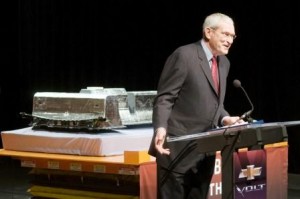
GM Chairman and former CEO Ed Whitacre at the launch of battery production, last January, at the Brownstown Twp. plant.
With General Motors moving closer to the launch of its new Chevrolet Volt, workers at the the company’s new battery plant outside Detroit have opted to become members of the United Auto Workers.
Officials from both the UAW and GM said workers at the battery plant have voted to join the union via a “card-check” vote under a procedure approved by the company and the union during contract negotiations in 2007.
In recent months, UAW militants had criticized the union for allowing the plant to operate without union representation.
The card-check procedure, by eliminating the need for an election supervised by the National Labor Relations Board, makes it easier for the union to sign up new members. It also requires GM not to resist the UAW’s unionization drives among production workers.
The Brownstown Township plant currently has approximately 100 employees but the number is expected to grow as GM expands production of the 2011 Chevrolet Volt, its first extended-range electric vehicle.
The workers assembling the battery packs are considered highly skilled and the plant has to meet very strict quality guidelines.
Ron Gettelfinger, who was then UAW president, had predicted last spring the plant would eventually be unionized.
The only other plant of its kind is operated by Tesla, which has been producing battery packs in its San Carlos, California-based factory for the past few years.
Tesla’s battery packs are used in the Tesla Roadster and Daimler AG’s Smart ED, a 2-seat urban electric vehicle.
It also appears that most of the components that will be used in electric and hybrid vehicles such as the Chevrolet Volt will be made in plants where workers are paid what have become known as second tier wages.
The UAW’s 2007 contracts with GM, Ford Motor Co. and Chrysler LLC allow the company’s to hire new employees at $14.50 per hour.
The standard contract wage is $29. In addition, the benefit package for second tier workers is also limited.
Chrysler hasn’t rolled out its electric vehicle plans yet. But it has brought back almost all of its seniority employees from layoff and could begin hiring for the second tier if it needs to boost production at any of its plants.
Ford also has fewer than 200 blue-collar employees on seniority layoff, which means it is almost certain to hire new workers on the second tier when it begins building electric vehicle components at its plants in Ypsilanti and Sterling Heights.
